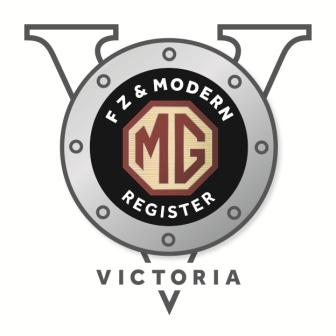 F, Z & Modern Register
F, Z & Modern Register
by Jeff
Turnbull, May, 2010
‘You should try one. It's bloody
good’ - Jeremy Clarkson
(UK
Motoring Journalist and Top Gear host).
There is no doubt that the world thinks of
the MG motor car in terms of small, nippy, red or green roadsters, (may we use
the term, ‘topless sports cars’?) which have been alternatively purring or hammering
around roads and racetracks since 1924 in a succession of models and variants.
Identifiable through their ‘sporty’ tag, their distinctive shape, wire wheels
and exhaust note, they have morphed through the pre-war ‘J’s, “K’s, ‘PA’s and
‘PB’s, the pre- and post- World War II ‘T’s, the ‘good times’ 50s and 60s MGAs
and MGBs, all the way to the re-born and revitalised MG F and T
F.
Yet hand-in-glove with the midget, (the GT
and V8 versions included), was a steady assortment of MG four door sedans,
‘salonettes’ or tourers, such as the pre-war MG Six, and the SA, WA and VA saloons.
In time, there came the sports-based 1¼ litre ‘family’ Saloon of 1947 (to be
named the MG Y), the Magnette, launched in 1953 and the front-wheel-drive MG Sports
1100 introduced to the motoring public in 1962.
It is true that the latter models were
badge-engineered for convenience in an era where this was considered expedient and
cost-saving and this would basically continue up to, and include the 2001-introduced
‘Z’ range of hatchbacks, saloons and wagons. The 60s MG 1100 and 1300 were up-graded
versions of the British Motor Company’s (BMC) Morris and Austin sedans. Yet for
all of these MG re-badged sedans, the ‘ordinary’ was dispensed with as much as
possible and regardless of the parent company/owner, MG was keen to promote the
‘sporting’ pedigree of the name as a step up from the run-of-the-mill models.
These sedans which carried the MG name and distinctive grille were a little more
engineered and improved when compared to their Austin and Morris (or in later
years, Rover) brethren.
When MG ceased production altogether in
1980, continuation into the future of any new MG vehicles looked bleak indeed.
Yet, it seemed that the name and reputation established by these two small
letters – MG – was far too significant to be assigned to the scrapheap of the past.
Could there be a possible stay of execution for MG roadsters and saloons? The
answer clearly was – YES! Rover was to come to the aid of the motoring public
and pick up the remains of British Leyland; the future seemed a little brighter.
Thus MG was rescued and resurrected and not for the last time. Then, following
the successful release in 1995 of the all-new MG F came the return of the MG sporting
saloon in the form of the MG Z
series. Here is their story embracing the years, 2001 to 2005 - and beyond!
MG ‘Zed’
background:
The range of MG ‘Zeds’ - ZS, ZR and ZT, began
life within the Rover organization and along with the generic Rovers, grew out
of the company’s post-BMW ownership era. BMW had taken over Rover in a 1994 deal
to keep the British car maker afloat and as a result, created BMW’s U.K. Division.
The parent company had made it very clear to the press from the beginning of
its takeover of Rover, that they had complete trust in the UK company’s ability to produce
exciting and desirable cars without any interference from them. That policy
soon had a hollow ring to it as the relationship between British and German
interests began to break down, but not before Rover produced the Rover 75 and
launched it at the Birmingham Motor Show in 1998.
However, by 2000, it was curtains for BMW’s
interests in Rover; they were to pull out of the deal and hand all production,
planning and assembly of future Rover cars to John Tower’s
Phoenix Venture Holdings. As part of this new deal, all Rover 75s were to be
assembled at Longbridge. In time, and in light of the enormous success of this
sedan, a decision was made to develop a sportier model which would differ in
that it would proudly wear the MG badge. It was intended to make the new MG somewhat
akin to the Rover 75 Sport which had recently debuted at Geneva. The new top-of-the-range MG was code-named
the X10 for the saloon and X11 for the intended Tourer version and would in
time, become the ZT.
When launched, the trio was heralded by a
sales pitch informing us that:
‘MG
roars right up to date with a set of saloons that really kick. No smoke, no
mirrors. … On the outside it’s about attitude and plenty of front, with that
legendary badge fenced by taut, bright mesh and piercing lamps. Now climb
inside… Behind the racing-style wheel, leather and cloth seats brace your body
for the ride ahead. … Just when you thought you might have to be sensible, MG
brings out a whole new set of temptations. …’
MG ZR
Hatchback:
At precisely the
same time as the ZT project come to fruition, MG Rover launched the MG ZR (designated X30) 5-door ‘hot hatch’,
as it was called in the press on its release in 2001. This
car was based on the Rover 40 and in fact, had originally been the chosen
design for the Rover 25 Series GTi, before the BMW takeover.
The ZR, designed by a team headed by Rod
Oldaker, offered a choice of models: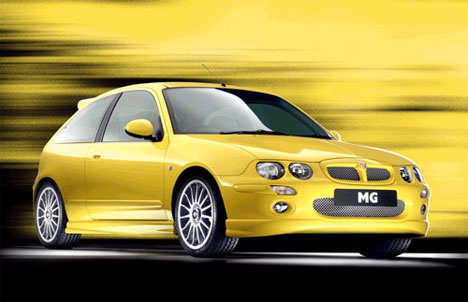
ZR 105. The 1.4
K series engine produced 105 bhp (78 kW; 106 PS) and
123 N·m (91 lb·ft) torque giving 0–60 mph (0-100 km/h) in 9.8 seconds
and a top speed of 111 mph (179 km/h).
ZR 120. It came with a 1.8 K series engine that produced
115 bhp (86 kW; 117 PS) and 160 N·m (120 lb·ft) torque
giving 0–60 mph (0-100 km/h) in 8.6 seconds and a top speed of 119 mph
(192 km/h).
ZR 160. Featured a 1.8 K Series
VVC engine producing 157 bhp (117 kW; 159 PS) and 174 N·m
(128 lb·ft) torque giving a 0–60 mph (0-100 km/h) in 7.4 seconds and a top
speed of 131 mph (211 km/h).
ZR TD 100 (diesel). Had a 2.0 L Series engine that gave 99 bhp
(74 kW; 100 PS) and 240 N·m (180 lb·ft) torque giving 0-60 mph (0-100 km/h) in 9.7 seconds and a top
speed of 114 mph (183 km/h).
ZR TD 115 (diesel). It came with the same 2.0
L series engine but with some minor enhancements which kicked up the
performance to produce 111 bhp (83 kW; 113 PS) and 260 N·m
(190 lb·ft) torque This saw the car go from 0-60 mph(0-100 km/h) in 9.1
seconds and produce a top speed of 116 mph (187 km/h).
The mechanical modifications as compared to
the Rover 40 featured an upgraded sports suspension and a throatier exhaust.
The ‘K’- series engine used in the ZR, (the same power plant as in the MG F,) also
suffered from the same diabolical head gasket problems as the roadster and
ended up being featured in a BBC media investigation into the problem. Comments
were made about the alleged sub-standard finish of the car as this seemed
frankly unacceptable to some discerning buyers and nit-picking motoring
journalists whose job it was to be hypercritical. Body roll and tough, tight, uncompromising
suspension made the car less than comfortable to some drivers and the interior,
again to some, seemed to be upgraded only minimally from the Rover 40. Yet
despite this, the ZR Hatchback was popular in Britain with younger buyers who
were lured into buying with offers of free insurance and enticing discounts. The
ZR essentially replaced the MG Metro. In 2003, the ZR Express, which was in essence, a fast 2-seater delivery van,
designed for nipping around London,
was released.
During 2004, a facelifted ZR was released at
the same time that all other MG Rover models were similarly upgraded. The re-vamped ZR, (now styled Mk 2) saw
the introduction of the Trophy and Trophy SE models. The MG ZR Trophy featuring
a sunroof, 16-inch ‘Grid-spoke’ alloy wheels, new rear light clusters, a
leather steering wheel and side sill and rear bumper extensions. The Trophy SE
featured 17-inch alloy wheels and had air conditioning installed, but no
sunroof. These models would continue until the collapse of MG Rover in 2005 and
the discontinuation of all MG models which eminated from the company. Estimates
are that 82,088 ZRs were built.
MG ZS
The badge-engineering trend for MG was to
continue with the MG ZS (designated X20) released to the public as one of the
new MG trio of vehicles in 2001. The company had in mind the European and
Japanese markets when looking at a car to match the Honda Civic. Indeed, at the
time of the early development of the car, Rover and Honda were actively working
together to exploit these markets.
The
ZS was hastily, yet efficiently created from the Rover 45, which had been
launched on the market in 1999. MG’s 2001 release followed the withdrawal of
BMW interests with MG and Rover. The Rover 45, which wasn’t necessarily a
driver’s car, was given the MG treatment. In its Rover form, comfort was
paramount with power and handling, a secondary consideration. However as an MG,
this prioritization was somewhat reversed. Honda was to provide the double
wishbone suspension to the front end and multi-link rear suspension while the
‘K’ -series engine was used along with the 2.5-litre
KV6 engine.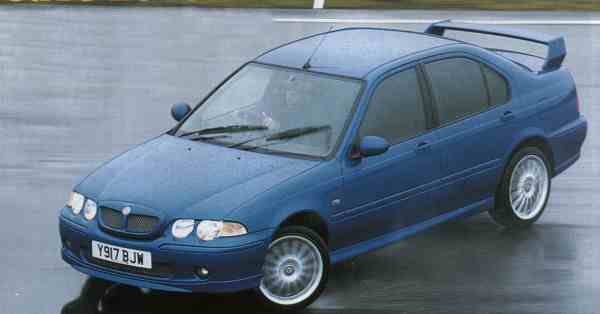
A
team under Phoenix’s
Managing Director Peter Stevens, worked to beef-up the aggressiveness as much
as possible for this car. At design stage, the idea was conceived to add a huge
rear spoiler as carried by the Suburu Impreza P1 and the Mitsubitshi Lancer Evo
VI to make it look tough, gutsy and racetrack-ready.
In
the end, Design Chief Oldaker was well satisfied with the result: a very
capable chassis that handled and rode very well coupled with the tried and
proven K-Series engine. If they were looking for the
reward for all the effort and sweat expended by Oldaker and his team to make
this model work, then work it did!
The MG ZS was probably the most successful of the trio of new MGs released in
2001, in terms of overall sales.
The ZS models were as follows:
ZS105 with a 1.4 L K-Series engine delivering 103 bhp (77 kW) at 6000 rpm. Top speed was
115 mph (185 km/h), going from 0-60mph (0-100
km/h) in 10.8 seconds.
ZS110 had a 1.6 L K-Series engine producing 107 bhp (80 kW) at 6000 rpm. Top speed was
119 mph (192 km/h). It was able to go from 0-60mph (0-100
km/h) in 9.8 seconds.
ZS120 was
powered by a 1.8 L K-Series engine producing 115 bhp (80 kW) at 5500 rpm. Top speed was
122 mph (196 km/h), going from 0-60mph (0-100
km/h) in 9.0 seconds.
ZS120 Auto had a 1.8 L K-Series engine producing 115 bhp (80 kW) at 5500 rpm. Top speed was
115 mph (185 km/h), going from 0-60mph (0-100
km/h) in 9.9 seconds.
ZS180 had a 2.5 L L-Series KV6 engine producing 175bhp (130 kW) at 6500 rpm. It was capable of a top speed
was 139 mph (224 km/h). It was able to go from 0-60mph (0-100
km/h) in 7.3 seconds.
ZS TD 115 had a 2.0
L L-Series engine producing 111 bhp (83 kW) at 4200 rpm. Top speed was 120 mph
(193 km/h). It went from 0-60mph (0-100
km/h) in 9.5 seconds.
The 2004 update process on all MG
models saw the MG ZS and Rover 40 become quite noticeably different, whereas
since the ZSs release in 2001, both cars shared a similar outward appearance,
particularly in the ZS 180 version. There were new wheel arch extensions fitted;
the side vents and other exterior styling features were refined. As with the
ZR, the 2004 version of the ZS came with a revised interior styling and new
seat materials. Finally, there was a newly-designed dash which incorporated the
climate control on some models.
But, all production of the ZS was
to cease in April 2005 with the collapse of MG Rover and some 27,540 (estimate
only) rolled off the assembly lines. Honda actually repossessed some of the
rights they held for the original 1995 Rover/MG design. The number of ZSs which
reached Australian shores could be as few as 24, (speculation only).
MG ZT and
ZT-T Estate Wagon:
The larger ZT was marked out as the
‘flagship’ model for the trio of ‘Zeds’ released in Britain in 2001. It comprised the ZT
Sedan (codenamed X10) and the ZT-T Estate Wagon (X11). Of all models
in the ZR/ZS/ZT range, this is the one which most took on in Australia, perhaps because of our
predisposition towards larger family cars such as the Holden Commodore and Ford
Falcon ‘big sixes’ of the time. But the ZT couldn’t be considered a serious
threat to these two market leaders – it was more of an enthusiast’s sedan or
wagon intended to gain a corner of the market.
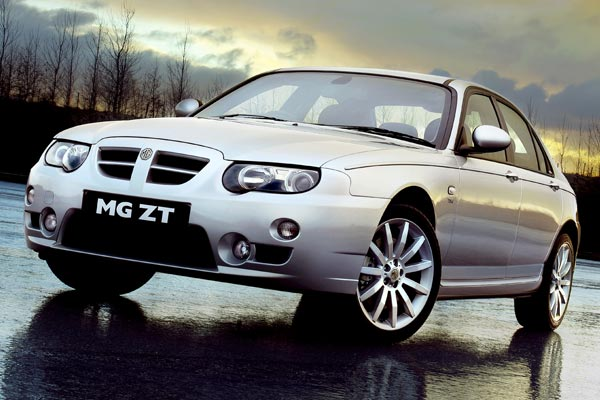 The
ZT commenced life as a Rover 75 and Peter Stevens placed his mark on the
styling of the car to create an MG. Again, Rod Oldaker supervised the chassis-design
team and focused on this aspect of the car, such as attaching the suspensions
to the subframes with aluminium mounts, rather than rubber. Up-rated dampers
and anti-roll bars were planned and the spring suspension was increased by 70%
on the Rover. There is no doubt that these points were enough to separate the
MG ZT from the Rover 75.
The
ZT commenced life as a Rover 75 and Peter Stevens placed his mark on the
styling of the car to create an MG. Again, Rod Oldaker supervised the chassis-design
team and focused on this aspect of the car, such as attaching the suspensions
to the subframes with aluminium mounts, rather than rubber. Up-rated dampers
and anti-roll bars were planned and the spring suspension was increased by 70%
on the Rover. There is no doubt that these points were enough to separate the
MG ZT from the Rover 75.
On
the outside the stylish and distinct MG grille clearly
announced that this was an obvious successor to the line of sporting saloons
and this time, as a very first for MG – an Estate Wagon was released. (Station
Wagon to us!) There were new halogen projector headlamps, lower driving lamps
and indicators incorporated into the front bumper, which was completed by the
spoiler at the base of the bumper. The body was remarkable free of chrome bits
– unlike the Rover.
All ZT models carried a distinctive interior
package, with firstly, sports seats which could be described as ‘body-hugging’.
They were magnificently supportive and their heavy bolstering, offered excellent
cornering when pushing the car into and out of twisty bends. There was a new
dashboard layout, now using a special Technical Grey finish. The console could
be Black Oak as an option as well as the fascia treatment, all set off by a
Black Oak wood steering wheel with the large MG logo in the centre. Burr Walnut
was another option for the interior. New instrument gauges were backlit
illuminated in blue lighting and there were metal-look plastics on the
dashboard and a leather-covered gearshift, handbrake and steering wheel. New ‘Summit’ fabric sports seat
could also be specified on some models and black leather trimmed sports seats were
standard on the SE options. All of these improvements met with considerable
acknowledgement from the motoring scribes and the public alike. The ‘+’ pack
added leather/Alcantara trim for the sports seats, an electric glass sunroof, a
trip computer, rear parking sensors and automatic dipping mirror. For an
additional $2000, a buyer could have automatic climate control.
Initial ZT models were in V6 form but other
variants were added to the range:
ZT 115/115+ CDT - Turbo Diesel – BMW
unit -114bhp (85kW)
ZT 135/135+ CDTi - Turbo Diesel – BMW unit -131bhp (98 kW)
ZT 120/120+ - 1.8 K-Series engine
ZT 160/160+ - At first, a 2.5 litre KV6, later a
supercharged 1.8 K-Series engine
ZT 190/190+ - 2.5 litre KV6, 190PS
ZT 180+ - KV6 with JatCo automatic gearbox 177PS
ZT 260+ - 4.6 litre V8,
with a version of the Ford Mustang V8 engine
MG Rover stated that the manual ZT sedan could reach 0-100km/h in
8.2 seconds and the automatic in 9.5 seconds. For the ZT-T wagon, the claim was
8.7 (manual) and 10 seconds (auto).
The
standard driver-friendly manual gearbox which allowed the driver to engage
directly with the car was complimented by the auto which, on today’s roads,
seems to be the transmission-of-choice for the average driver. The suspension
was deemed to be capable of soaking up the bumps well, while some felt it was a
little on the soft side for the ‘big’ potholes. As with other models, the build
quality was under scrutiny when compared with Japanese and European marques. The wide-ish gap where the front bumper meets the bonnet can appear
to reflect negatively on the build quality, but this is not the case. It is in
the design.
For
the Australian release in 2004, (facelift models) two new performance models
were added: the ZT 260 and a
locally-developed ZT 220S –
with a supercharged version of the V6 engine. Prices in Australia were at the time: $59000
for the ZT 190 manual and $60990 for the auto, and the ZT260 V8 was $89,990,
placing them up there in the lux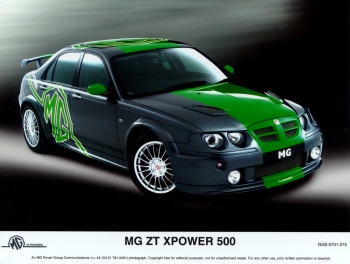 ury range.
ury range.
MG Xpower – well… that’s another
story! This project highlights just how far Peter Stevens and his crew were
willing to go to provide a true fire-breathing luxury sportscar with raw V8 power.
It was designed to make an ‘in-your-face’ challenge to the ‘exclusive’
saloon-based roadsters such as Porche and Lamborghini – something that would
take MG away from their roots in providing affordable roadsters. In the end the
SV-R which cost as much as a Porche 911, possibly sold 9 cars – well and truly
collectors items in years to come, if not already in that league.
As a postscript really, many will
be aware that the ZT-T is now firmly cemented in the Guiness Book of Records as
the fastest Estate Wagon/Station Wagon yet produced. But, to do this Peter
Stevens had to go well beyond the common garden variety, road-based wagon. His
team took a V8 wagon in 2002 and handed it over to the
legendary California-based, custom car specialists, So-Cal Speed Shop to build
and then run the car. This MG ZT-T, which carried the code name, X-15, reached a top speed of 225.609 mph
(360.9 km/h) in August 2003, at the 55th annual Bonneville Speed Week
Nationals, on the Salt Flats in Utah, USA. Peter Stevens told the press.
‘This is
not just about setting world records, this is about testing MG's vehicles to
their limits, in
some of the most extreme conditions you
can find in the world. The added challenges of meeting
strict
technical and safety regulations which are set by the Southern
California Timing Association
make our
achievement of 225.609 mph with a virtually stock MG ZT-T all the more
satisfying,’
Stock-standard ZT-T? Is he kidding us?
The
number of saloons and wagons imported into Australia is certainly open to
conjecture because Rover 75 and MG ZT numbers were lumped together. Since ZTs
were first introduced in May, 2002, some figures indicate that for that initial
year, perhaps 300 plus ZTs were sold here. For 2003, guess-timate figures
indicate that just over 200 may have been sold and for 2004, this probably fell
to less than 200, Australia-wide. What we do know is that estimates indicate a
total of 27,149 units were built at Longbridge in the period 2001-5, meaning
that Australia
was really only a tiny export drop in a much bigger market.
There is no need to repeat the scenario of
the final days of the Zeds and the collapse of MG Rover. Remarkably, in Australia
the plummeting depreciation on all Zed models today is significant on the used
car market – all can be bought second-hand for a fraction of what their
original purchase price was. Most are still brilliant motor cars, looked after
because they were, after all … MGs! Perhaps, as they become collectors’ items
and are lovingly kept and added to the stables of MG enthusiasts, their value
in future may steadily increase – who knows!
MG 7:
Following the rescue package from Nanjing which was to breathe new life into MG
all over again, they were to release in 2007 the MG 7 - a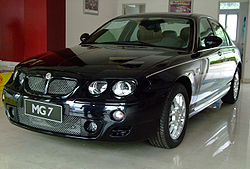 variant of the Rover
75/MG ZT. Two distinct models were released: the first, reminiscent of the Z
with its twin headlights, and the second not unlike the Rover 75 V8. The distinction
between the 7 and the ZT/75 packages was in newly-designed LED rear lights and new
alloy wheels. Most importantly – the 7 added an extra 200mm to the length –
mostly to compensate for the lack of leg-room for rear passengers in the ZT.
Heralded also was the lavish interior and DVD screens.
variant of the Rover
75/MG ZT. Two distinct models were released: the first, reminiscent of the Z
with its twin headlights, and the second not unlike the Rover 75 V8. The distinction
between the 7 and the ZT/75 packages was in newly-designed LED rear lights and new
alloy wheels. Most importantly – the 7 added an extra 200mm to the length –
mostly to compensate for the lack of leg-room for rear passengers in the ZT.
Heralded also was the lavish interior and DVD screens.
The 7 included a new audio and new
heating systems and an all-new sunroof. Two engines were available: the
N-Series 1.8T producing 160bhp and the 2.5 V6 with a 177bhp capacity. Changes
to the electrical ignition system were made to cope with upgraded electricals.
The MG 7 came with two extra trim options: ‘Classic’ which featured a
slatted grille, and ‘Sport’ with a mesh grille, reminiscent of 2001 ZTs. In
2004, a coupe version was unveiled to the public, but this was at the critical
time of the collapse of MG Rover and it disappeared from sight altogether. The
MG 7 still continues in production at the point of writing.
MG 550 and MG 750: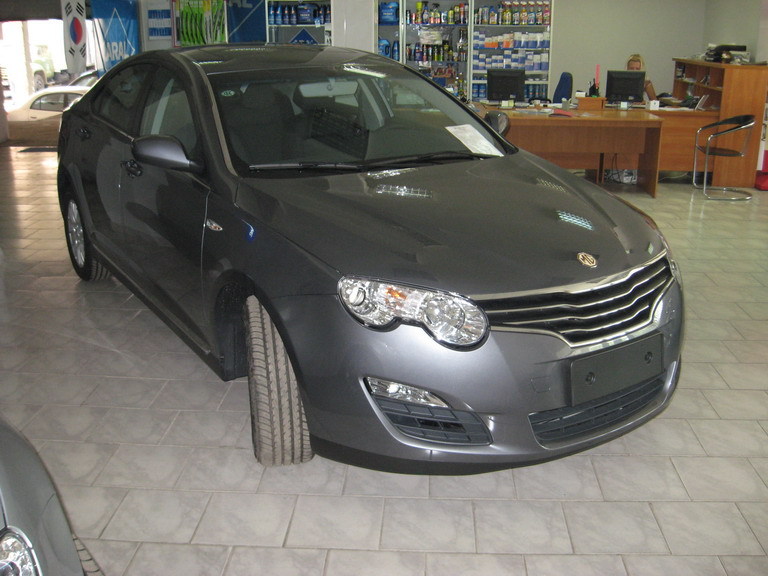
Following the Chinese resurrection of the MG brand, Roewe (pronounced
‘Rong-wei’) in 2008 launched its sedans in, of all places, Chile and re-badged them respectively
as the MG 550 and the MG 750. They were based on the Rover 75/Roewe
750. The 750 had Xenon
Headlights and a fully integrated SatNav system. The 550 had been designed by former British MG
Rover engineers for Roewe’s parent company, Shanghai Automotive Industry Corporation’s (SAIC) as the successor to the Rover 45.
In mid-July, 2009 MG-badged
versions of the Roewe 550 and 750 were on sale at a SsangYong dealer in the Belarus’ capital, Minsk. It would appear in the re-branding stakes,
that SAIC is content to keep the Roewe badge for its domestic sales and have
re-badged (MG) versions of its cars on sale internationally – one brand for
home, one more recognizable brand for the world. By the way – Chileans who want
to buy an MG 550 in Santiago
will pay out currently, 10.5 million pesos, (about $AUD16,000!).
MG 6:
The 2009-released
MG 6 opens up a new era for MG worldwide. Whereas the ‘Zed’ story abruptly concluded
with the final collapse of the Rover-MG company in 2005, the latest Chinese-backed
MG 6 debuted at the Guangzhou
Auto Show on 24 November, 2009, possibly heralding in an exciting
future for Cecil Kimber’s creation as we progress into the second decade of the
new millenium. It is a four-door, five-seater hatchback sedan, and like the MG
550 and 750, is based on the Roewe 550. This Chinese model in turn also counts
the Rover 75 as a predecessor and sports a newer, updated MG octagon badge –
representing a very strong commitment to the MG brand from the Chinese auto
giant.
It is a sharp, European-styled car,
reminiscent of the Lexus GS with an all-new angular front which leads the eye
directly to the large, centralised MG badge. It is powered by a slightly updated version of the
familiar 1.8-litre K-series engine – now known as N-series and will have a
turbocharged version on the market. This car is now being
constructed at the former MG Rover plant at Longbridge, U.K.
where the design team originally conceived the car – which seems fitting really,
bringing the MG back to its British origins.
So, with the MG 6, the story of the MG ‘moderns’
is brought up to date … to this point in time, at least. But, stand by for
future updates! Whereas the ‘Zed’ range ceased production in 2005, the
tradition of family and sporting saloons continues into the future. But as for Australia,
we have dealerships which could again be willing to offer MG cars to the local
market but finding an importer is the stopper at present. We will just have to
sit back and envy overseas drivers (like those in Santiago
and Minsk!) who
can purchase and enjoy the new generation of MG saloons and roadsters.
Noticed an error, omission
or have extra information? Please let me know.
Sources:
Adams, Keith, ‘MGs for a new millennium:
from X to Z’, www.aronline.co.uk
Various sales brochures
www.autoweb.com.au
www.british-cars.net
www.digiads.com.au
www.en.allexperts.com
www.mgcars.org.uk
www.mgownersclub.co.uk
www.en.wikipedia.org
Back to F, Z & Modern Register Home Page





 ury range.
ury range.

 variant of the Rover
75/MG ZT. Two distinct models were released: the first, reminiscent of the Z
with its twin headlights, and the second not unlike the Rover 75 V8. The distinction
between the 7 and the ZT/75 packages was in newly-designed LED rear lights and new
alloy wheels. Most importantly – the 7 added an extra 200mm to the length –
mostly to compensate for the lack of leg-room for rear passengers in the ZT.
Heralded also was the lavish interior and DVD screens.
variant of the Rover
75/MG ZT. Two distinct models were released: the first, reminiscent of the Z
with its twin headlights, and the second not unlike the Rover 75 V8. The distinction
between the 7 and the ZT/75 packages was in newly-designed LED rear lights and new
alloy wheels. Most importantly – the 7 added an extra 200mm to the length –
mostly to compensate for the lack of leg-room for rear passengers in the ZT.
Heralded also was the lavish interior and DVD screens.